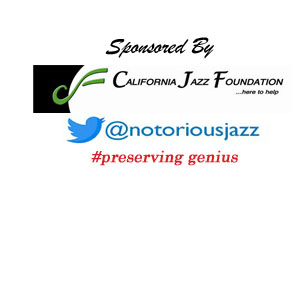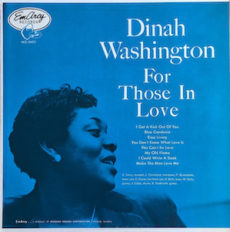
Requisites
For Those In Love ~ Dinah Washington | By Eddie Carter
To the singer of jazz ballads, standards, or contemporary hits, a song is comprised of three essential parts, melody, harmony, and rhythm. When all three elements are mixed, and enhanced by great arrangements and musicians, the result is an enriching music experience. This morning’s choice from the library is by Dinah Washington, a vocalist who sang the blues, jazz, pop, and R&B proficiently. The album is For Those In Love (EmArcy MG 36011), recorded and released in 1955. She’s joined on this date by Clark Terry on trumpet, Jimmy Cleveland on trombone, Paul Quinichette on tenor sax, Cecil Payne on baritone sax, Wynton Kelly on piano, Barry Galbraith on guitar, Keter Betts on bass, and Jimmy Cobb on drums. The arrangements are by Quincy Jones and my copy used in this report is the second 1955 US Mono release featuring the silver Mercury Records oval at the noon position of the label with EmArcy Jazz appearing in the bottom of the oval.
The opener is I Get a Kick Out of You, written by Cole Porter for the 1934 Broadway musical, Anything Goes, and the octet gets right to work on this swinger. Dinah has the spotlight first and gives a splendidly entertaining improvisation. Jimmy follows, having a ball on a spirited statement, then Kelly displays impeccable chops on a relaxed reading. Clark comes in for some savory swinging with a mute on the closing solo, and Dinah handles the finale with great effectiveness leading the group into a slow fade. Blue Gardenia by Lester Lee and Bob Russell was composed for the 1953 crime drama, The Blue Gardenia. It became a signature song for Dinah and the octet offers a supporting role behind her delicately subtle narrative. Quinichette gives a brief statement of tenderness, then Galbraith offers a solo of soft tranquility. Payne has a moment in the spotlight adding a dreamlike softness to the closing solo. Dinah wraps up the song with emotional sensitivity on the climax.
Easy Living by Ralph Rainger and Leo Robin was the main theme of the 1937 comedy of the same name. The group provides a perfect complement to Dinah’s luxurious vocals on the opening chorus, and the solo order is Paul, Clark, and Jimmy. The first two readings are like delicate porcelain figurines, perfectly proportioned and translucent. The pace picks up slightly for the trombonist who plays the next interpretation with sensual beauty. Ms. Washington is especially attractive on the reprise with a velvety, smooth timbre in her voice that’s gorgeous. You Don’t Know What Love Is by Gene de Paul and Don Raye is a perfect song for film-noir. The haunting lyrics describe the hurt and sadness at the end of a love affair. It opens with a solemn introduction by Dinah and Galbraith. She captures the subtle pathos of the song with the octet’s soft supplement. Cleveland provides the song’s only solo with a graceful and elegant interpretation before Dinah returns to the melancholy mood of the beginning.
This Can’t Be Love by Richard Rodgers and Lorenz Hart was written in 1938 and featured in the Broadway musical, The Boys From Syracuse. The mood is jubilant, and Dinah rises to the occasion with a vivacious vocal treatment. Clark’s muted trumpet sets a lively mood on the first solo. Cecil is up next with an energetic performance of his own. Jimmy mines a vein of unsuspected riches on the third statement, then Paul delivers a delightful interpretation. Kelly cooks up a mesmerizing musical brew before Dinah sings the closing chorus. My Old Flame by Arthur Johnston and Sam Coslow made its debut in the 1934 film, Belle of The Nineties. Dinah begins this tune as a duet with Galbraith preceding the rhythm section’s slow-tempo theme. She’s the dominant presence here and presides with authority, as she recounts her lost love some time ago in a reflective flashback. The horns make their presence known for the closing chorus with Dinah giving it the recognition it deserves.
The 1940 show tune by Rodgers and Hart, I Could Write A Book gets taken for a mid~tempo spin by Ms. Washington and the ensemble. The octet starts the song in unison for the introduction, then Dinah treats the listener to an effervescent vocal performance on the melody. Paul starts with a passionately playful lead solo. Terry adds some fire on the muted trumpet, then Cleveland ends the solos on an upbeat note. The album’s finale, Make The Man Love Me is by Arthur Schwartz and Dorothy Fields. Quinichette opens with a seductive introduction, then Dinah makes a passionate romantic plea with the lyrics. Paul takes the lead with a remarkably graceful solo, then Terry turns in a beguilingly beautiful statement. Kelly approaches the next performance with affective empathy and Cleveland soothes the soul on the closer. Dinah sings two verses of the Duke Ellington–Paul Francis Webster classic, I Got It Bad (and That Ain’t Good) before returning to the original lyrics for the coda.
It’s a solid summation to an album sparkling with marvelous music, exciting, evocative solos, excellent arrangements, and the extraordinary vocals by Dinah Washington that are exceptionally presented. She brought the lyrics she sang to life in each song. The Queen of The Blues, a title she gave herself, recorded a total of thirty-three LP’s for EmArcy, Mercury, and Roulette during her short recording career that began in 1952 and lasted only eleven years. Though her greatest hit, What a Difference a Day Makes came four years later in 1959, For Those In Love would become one of the strongest albums of her career. Dinah passed away from a drug overdose on February 14, 1963, at the age of thirty-nine. This is a gorgeous recording with a splendid soundstage that’ll take your breath away each time you listen. I found For Those In Love to be thoroughly enjoyable and recommend it as a wonderful starting point for any fan interested in exploring the music of Dinah Washington. After one audition, I’m sure you will too! ~ What a Difference a Day Makes (Mercury MG 20479/SR-60158) – Source: Discogs.com
~ I Get a Kick Out of You, Easy Living, My Old Flame, I Could Write a Book, I Got It Bad (and That Ain’t Good) – Source: JazzStandards.com ~ Blue Gardenia, Dinah Washington, Make The Man Love Me – Source: Wikipedia.org © 2021 by Edward Thomas
More Posts: choice,classic,collectible,collector,history,instrumental,jazz,music,vocal
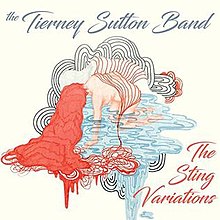
The Quarantined Jazz Voyager
Adapting and accepting the mask wearing, social distancing and self-quarantining has made life so much easier from this jazz voyager’s perspective. As we experience continued spikes in the coronavirus as the vaccine is rolled out, we still need to make the conscious effort to do our individual part to stave the spread.
So continuing my uninterrupted time to kick back, relax and listen to music, the album I have chosen The Sting Variations by vocalist Tierney Sutton. The recording session was arranged and produced by Trey Henry at LAFX Recording Services, The Doghouse Studio in May 2016, and released on September 9, 2016 for BFM Records.
The album was engineered and mixed by Zackary Darling, mixed and mastered by Michael Aarvold– mastering, mixing and earned the Tierney Sutton Band a Grammy Award nomination for Best Jazz Vocal Album.
Track List | 67:00- Driven To Tears ~ 5:47
- If You Love Somebody Set them Free ~ 5:53
- Seven Days ~ 6:17
- Shadows In The Rain ~ 4:37
- Walking In Your Footsteps ~ 3:50
- Fragile/Gentle Rain (Sting/Luis Bonfa/Matt Dubey) ~ 4:37
- Message In A Bottle ~ 4:27
- Fields Of Gold ~ 4:45
- Fortress Around Your Heart ~ 4:04
- Language Of Birds (Sting/Rob Mathes) ~ 5:09
- Every Little Thing He Does Is Magic ~ 3:02
- Every Breath You Take ~ 4:46
- Synchronicity ~ 4:11
- Consider Me Gone ~ 5:35
- Tierney Sutton – vocals
- Christian Jacob – piano
- Ray Brinker – drums, percussion
- Kevin Axt – double bass
- Trey Henry – double bass, bass guitar
This pandemic is here for the long haul. In the meantime, stay vigilant, wear masks and remain healthy and we’ll all be jet setting sooner than we think.
More Posts: adventure,album,club,genius,jazz,museum,music,preserving,restaurant,travel,vocal
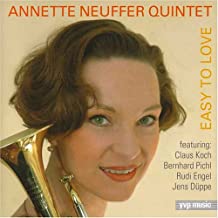
Daily Dose Of Jazz…
Annette Neuffer was born on January 15, 1966 in Munich, Germany. She didn’t start playing the trumpet until he was 18. Three years later she began studying music at the Graz University of Music , majoring in jazz trumpet . Another two yearsand she moved to the Stuttgart University of Music and Performing Arts, where she completed her diploma under Claus Stötter in 1996.
As a trumpeter she has worked with the Sarah Morrow Allstars in Paris, Benny Golson, Hal Singer, Mike Carr, Benny Waters, Jimmy Woode, and Horst Jankowski. In 1994 Annette was invited by the Sunday Night Orchestra as a singer for a project with Al Porcino. In 1995 she brought Porcino into his own big band, of which she was a singer for eleven years.
Since 2001 she has released four albums with her own quintet. She is an active composer and lyricist. She performed with the Bobby Burgess Big Band Explosion, Alexander’s Swingtime Band and Pete York. Vocalist, trumpeter, composer and lyricist Annette Neuffer continues to compose, perform and record.
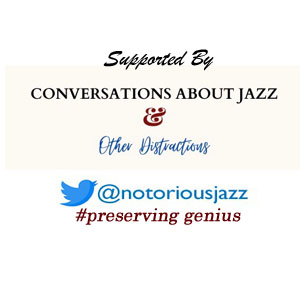
More Posts: bandleader,history,instrumental,jazz,music,trumpet,vocal
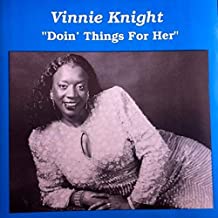
Daily Dose Of Jazz…
Vinnie Knight was born on January 5, 1958 in Harlem, New York and later moved to the borough of Brooklyn. At an early age, she sang in church choirs and performed in school plays and her father was a singer and guitarist who traveled the world. She studied dance with La Rocque Dance theater and music at the Juilliard School Of Music and Kings Borough Community College.
Knight recorded the songs of composer Duke Ellington, performed in Nairobi, Kenya, and starred with Oliver Jackson and the Harlem Big Band of New York, touring Germany, Switzerland, Holland, and Turkey. Returning to New York she performed with Clark Terry on the SS Norway cruise line, then played the Rapos Nightclub in Japan.
She has recorded, performed and collaborated with the best jazz musicians. In 1997 Vinnie moved to Virginia Beach, Virginia and began singing at such noted venues as Uncle Louie’s, The Jewish Mother, Bienville Grill, House of Jazz, as well as resorts, museums, concert halls and private events in Hampton Roads.
Her love for music theater had her writing and producing a musical revue called Black Pearls (The Speakeasy) songs from the 1920’s thru the 40’s; followed by the sequel Black Pearls and White Diamonds. In 2002, she performed a tribute to Ruth Brown and Pearl Bailey. Vocalist Vinnie Knight continues to perform, tour and record.
More Posts: bandleader,composer,history,instrumental,jazz,music,vocal
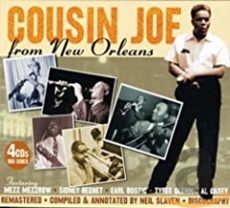
Daily Dose Of Jazz…
Pleasant Joseph, known as Cousin Joe, was born on December 20, 1907 in Wallace, Louisiana. He worked at Whitney Plantation throughout his childhood.
Until 1945 Cousin Joe toured Louisiana, and it was in that year he participated in the King Jazz recording sessions organized by Mezz Mezzrow and Sidney Bechet.
In the 1970s, he toured extensively throughout the United Kingdom and Europe, both individually and as part of the American Blues Legends ’74 revue organised by Big Bear Music. He recorded the album Gospel-Wailing, Jazz-Playing, Rock’n’Rolling, Soul-Shouting, Tap-Dancing Bluesman From New Orleans for Big Bear.
Blues and jazz singer Cousin Joe passed away on October 2, 1989 in his sleep from natural causes in New Orleans, at the age of 81.

More Posts: bandleader,history,instrumental,jazz,music,piano,vocal



